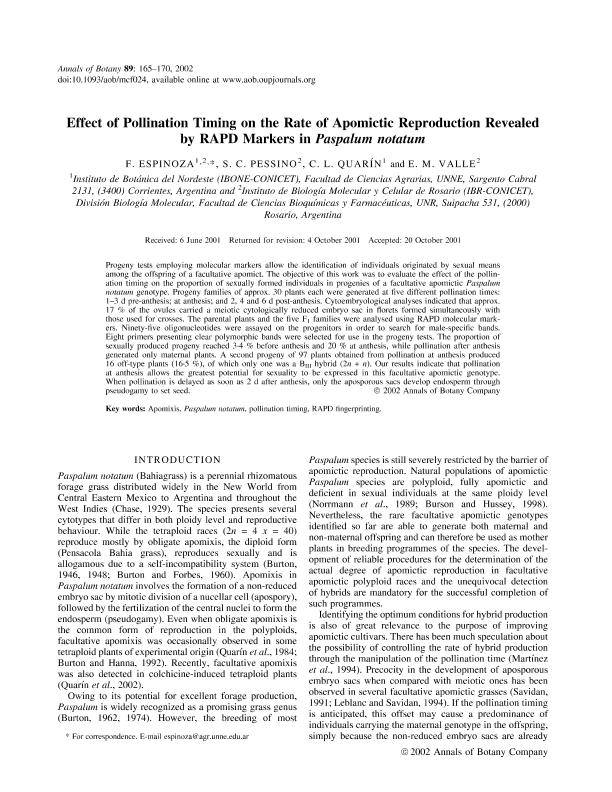Artículo
Effect of Pollination Timing on the Rate of Apomictic Reproduction Revealed by RAPD Markers in Paspalum notatum
Fecha de publicación:
02/2002
Editorial:
Oxford University Press
Revista:
Annals of Botany
ISSN:
0305-7364
e-ISSN:
1095-8290
Idioma:
Inglés
Tipo de recurso:
Artículo publicado
Clasificación temática:
Resumen
Progeny tests employing molecular markers allow the identification of individuals originated by sexual means among the offspring of a facultative apomict. The objective of this work was to evaluate the effect of the pollination timing on the proportion of sexually formed individuals in progenies of a facultative apomictic Paspalum notatum genotype. Progeny families of approx. 30 plants each were generated at five different pollination times: 1–3 d pre‐anthesis; at anthesis; and 2, 4 and 6 d post‐anthesis. Cytoembryological analyses indicated that approx. 17 % of the ovules carried a meiotic cytologically reduced embryo sac in florets formed simultaneously with those used for crosses. The parental plants and the five F1 families were analysed using RAPD molecular markers. Ninety‐five oligonucleotides were assayed on the progenitors in order to search for male‐specific bands. Eight primers presenting clear polymorphic bands were selected for use in the progeny tests. The proportion of sexually produced progeny reached 3·4 % before anthesis and 20 % at anthesis, while pollination after anthesis generated only maternal plants. A second progeny of 97 plants obtained from pollination at anthesis produced 16 off‐type plants (16·5 %), of which only one was a BIII hybrid (2n + n). Our results indicate that pollination at anthesis allows the greatest potential for sexuality to be expressed in this facultative apomictic genotype. When pollination is delayed as soon as 2 d after anthesis, only the aposporous sacs develop endosperm through pseudogamy to set seed.
Palabras clave:
Apomixis
,
Paspalum Notatum
,
Pollination Timing
,
Rapd Fingerprinting
Archivos asociados
Licencia
Identificadores
Colecciones
Articulos(IBONE)
Articulos de INST.DE BOTANICA DEL NORDESTE (I)
Articulos de INST.DE BOTANICA DEL NORDESTE (I)
Citación
Espinoza, Francisco; Pessino, Silvina Claudia; Quarin, Camilo Luis; Valle, Estela Marta; Effect of Pollination Timing on the Rate of Apomictic Reproduction Revealed by RAPD Markers in Paspalum notatum; Oxford University Press; Annals of Botany; 89; 2; 2-2002; 165-170
Compartir
Altmétricas




